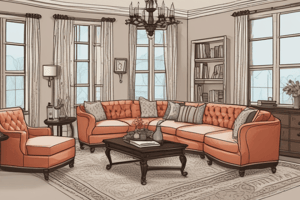Podcast
Questions and Answers
Which element of design refers to the area between objects in a room?
Which element of design refers to the area between objects in a room?
- Space (correct)
- Color
- Shape
- Texture
What type of line is associated with feelings of power, strength, and stability?
What type of line is associated with feelings of power, strength, and stability?
- Vertical Lines (correct)
- Curved Lines
- Horizontal Lines
- Diagonal Lines
Which dimension of color refers to how light or dark a color is?
Which dimension of color refers to how light or dark a color is?
- Value (correct)
- Intensity
- Chroma
- Hue
What effect do curved lines have on objects in design?
What effect do curved lines have on objects in design?
What is the first element to which viewers typically respond in a design?
What is the first element to which viewers typically respond in a design?
Which type of line creates a sense of activity and motion?
Which type of line creates a sense of activity and motion?
What is the term for how bright or dull a color appears?
What is the term for how bright or dull a color appears?
Which element of design is characterized by the solid form or structure of an object?
Which element of design is characterized by the solid form or structure of an object?
Flashcards
Interior Design
Interior Design
The scientific process of creating functional and beautiful living spaces.
Elements of Design
Elements of Design
The basic components used to create an interior design, such as space, shape, line, texture, and color.
Space
Space
The area between objects in a room.
Shape (Form)
Shape (Form)
Signup and view all the flashcards
Line
Line
Signup and view all the flashcards
Horizontal Line
Horizontal Line
Signup and view all the flashcards
Vertical Line
Vertical Line
Signup and view all the flashcards
Diagonal Line
Diagonal Line
Signup and view all the flashcards
Curved Line
Curved Line
Signup and view all the flashcards
Texture
Texture
Signup and view all the flashcards
Color
Color
Signup and view all the flashcards
Hue
Hue
Signup and view all the flashcards
Value
Value
Signup and view all the flashcards
Chroma (Intensity)
Chroma (Intensity)
Signup and view all the flashcards
Study Notes
English for Art Purposes
- Course preparation year: 2024/2025
- Instructors: Dr. Eman AbdAllah, Dr. Nahla Aly
- Prepared by: Ass. lec.: Neveen Eid
Introduction to Interior Design (part 1)
- Prepared by Ass. lec.: Neveen Eid
What is Interior Design?
- It is a scientific way to create a functional and beautiful living environment.
Is this Beautiful? (Natural Style)
Is this Beautiful? (Luxurious Style)
Is this Beautiful? (Boho Style)
Elements of Design
- Space
- Shape
- Line
- Texture
- Color
SPACE
- The area between objects in a room.
SHAPE OR FORM
- The solid form or structure of an object.
LINE
- The outline of an object.
- Two points that are connected, giving direction and dividing space
- Types of lines:
- Horizontal: Creates a feeling of sturdy, calm, and restful.
- Vertical: Creates feelings of power, strength, balance, stability, and height.
- Diagonal: Creates activity and motion
- Curved: Soften objects.
TEXTURE
- The way an object feels and looks.
- Can be rough, smooth, shiny, hard, soft, etc.
- Formal: Smooth texture
- Informal: Rough texture
COLOR
- One of the most important tools.
- Influences how people feel and the mood of the room.
- Dimensions:
- Hue: The name of the color (e.g., red)
- Value: How light or dark the color is (e.g., light red, dark red); this gives three-dimensional quality.
- Chroma (Intensity): How bright or dull the color is (e.g., bright red, dull red), strong reds, weak reds.
COLOR WHEEL
- A visual representation of colors arranged according to their chromatic relationships.
- Primary Colors: Colors at their basic essence; cannot be created by mixing other colors.
- Secondary Colors: Colors achieved through mixing two primary colors.
- Tertiary Colors: Colors achieved by mixing a primary and secondary color.
- Complementary Colors: Colors located opposite each other on the color wheel.
- Analogous Colors: Colors located close together on a color wheel.
- Value: The relative lightness or darkness of a color.
Studying That Suits You
Use AI to generate personalized quizzes and flashcards to suit your learning preferences.




